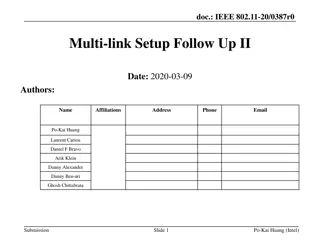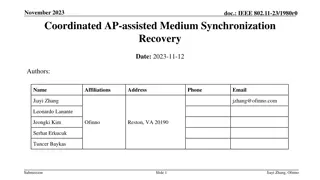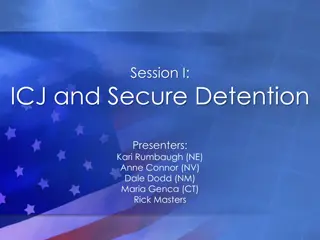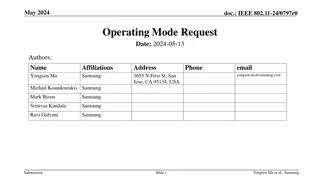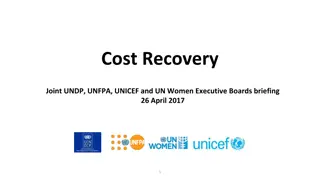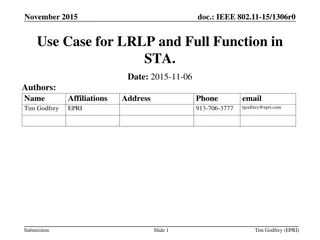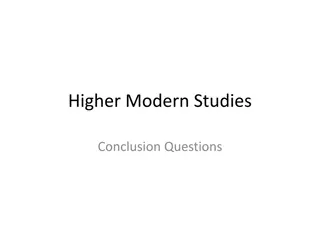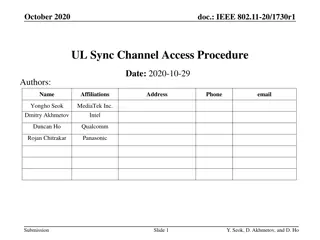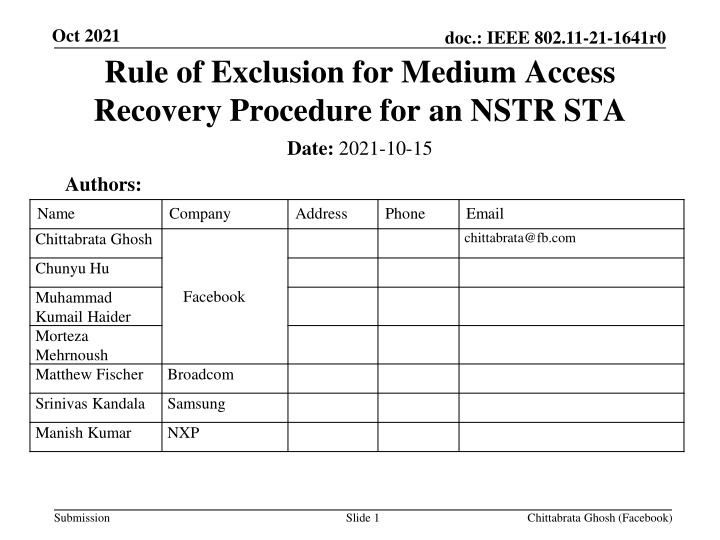
Medium Access Recovery Procedure for NSTR STA
"Learn about the Rule of Exclusion for Medium Access Recovery in IEEE 802.11-21-1641r0 document. The proposal addresses issues of self-interference, medium blindness, and synchronization for STAs in NSTR link pairs, providing detailed insights and solutions." (272 characters)
Download Presentation

Please find below an Image/Link to download the presentation.
The content on the website is provided AS IS for your information and personal use only. It may not be sold, licensed, or shared on other websites without obtaining consent from the author. If you encounter any issues during the download, it is possible that the publisher has removed the file from their server.
You are allowed to download the files provided on this website for personal or commercial use, subject to the condition that they are used lawfully. All files are the property of their respective owners.
The content on the website is provided AS IS for your information and personal use only. It may not be sold, licensed, or shared on other websites without obtaining consent from the author.
E N D
Presentation Transcript
Oct 2021 doc.: IEEE 802.11-21-1641r0 Rule of Exclusion for Medium Access Recovery Procedure for an NSTR STA Date: 2021-10-15 Authors: Name Chittabrata Ghosh Company Address Phone Email chittabrata@fb.com Chunyu Hu Facebook Muhammad Kumail Haider Morteza Mehrnoush Matthew Fischer Broadcom Srinivas Kandala Samsung Manish Kumar NXP Submission Slide 1 Chittabrata Ghosh (Facebook)
Oct 2021 doc.: IEEE 802.11-21-1641r0 Background A pair of links is indicated by a STA MLD (multi-link device) as an NSTR pair signaled in transmitted Association Request frame A transmission on one link (e.g., lower 5 GHz band) will cause self interference (due to signal leakage) on the second link (e.g., upper 5 GHz or in 6 GHz band) within an NSTR pair, making the second link unsuitable for reception of PPDUs This self interference results in medium blindness for the STA in the second link Due to medium blindness, the draft spec defines this duration of transmission in one link as the duration of lost medium synchronization IEEE 802.11be defined a medium access recovery mechanism to allow the STA to come out of medium blindness This proposal provides a resolution to CID 4730 (in next Slide) Submission Slide 2 Chittabrata Ghosh (Facebook)
Oct 2021 doc.: IEEE 802.11-21-1641r0 Details of CID 4730 CID Clause Number 35.3.14.7.1 Page Line Comment Proposed Change 4730 279 41-46 In my opinion, an additional exclusion rule is needed: If the TX PPDU duration in one link is less than the time remaining in the received PPDU on the other link as indicated by the RX PPDU SIG field, then the STA in the other link does not lose medium synchronization; in essence, as long as the STA is able to decode a Rx PPDU in the other link, the STA should not be considered to have lost medium synchronization. Please include the exclusion scenario mentioned in the comment "A STA affiliated with a non-AP MLD that belongs to a NSTR link pair is considered to have lost medium synchronization (due to UL interference) when the other STA, which is affiliated with the same MLD and belongs to that link pair, transmits a PPDU, except under the following condition: --Both STAs ended a transmission at the same time." Submission Slide 3 Chittabrata Ghosh (Facebook)
Oct 2021 Problem Statement: Recovery using Medium Sync Delay doc.: IEEE 802.11-21-1641r0 Medium access recovery: In SC 35.3.14.7.1, the following is stated (illustrated in Figure below): A STA affiliated with a non-AP MLD that belongs to a NSTR link pair is considered to have lost medium synchronization (due to UL interference) when the other STA, which is affiliated with the same MLD and belongs to that link pair, transmits a PPDU, except under the following condition: Both STAs ended a transmission at the same time: Problem: The underlined statement forces a STA to have lost medium synchronization even when a STA can decode a received frame partially or completely Proposal is that successful decoding is included as an exclusion criteria (with additional rule) The spec (in same SC) further states that A STA that has lost medium synchronization due to transmission by another STA affiliated with the same MLD shall start a MediumSyncDelay timer at the end of that transmission event if that transmission event is longer than aMediumSyncThreshold. Maximum value of MediumSyncDelay is 8.2ms (8 bit field called Medium Synchronization Duration), implying waiting time of ~8ms after the end of the transmission in the other link For a STA with latency sensitive application, this wait time is unacceptable Link 1 STA Tx STA MLD Lost medium sync STA Rx Link 2 Initiates MediumSyncDelay (max. ~8ms) Submission Slide 4 Chittabrata Ghosh (Facebook)
Oct 2021 doc.: IEEE 802.11-21-1641r0 Proposal 1: Exclusion Rule to Medium Access Recovery STA may start receiving a packet in Link 2 either before or during the transmission of a packet in Link 1 STA on Link 2 decodes at least the non-HT PHY preamble of a receiving packet Non-HT-STF, non-HT-LTF, and non-HT SIGNAL (L-SIG) fields (where L-LENGTH parameter value defines the remaining PPDU duration) If the adjusted PPDU duration of the receiving packet in Link 2 is > or = remaining Tx duration on Link 1 STA does not lose medium access synchronization STA defers channel access till the end of the PPDU duration (decoded from L-SIG field) it is receiving and resumes channel access / contention as in baseline STA shall not be required to initiate MediumSyncDelay as defined in SC 35.3.14.7.1 in this case If the adjusted PPDU duration of the receiving packet is < remaining Tx duration on Link 1 STA performs medium access recovery as in SC 35.3.14.7.1 or wait for a new packet reception Link 1 STA Tx Non-HT-PHY preamble (20us) STA MLD STA Rx Link 2 PPDU duration (indicated by L_LENGTH in L-SIG) Submission Slide 5 Chittabrata Ghosh (Facebook)
Oct 2021 Proposal 1 (Option 1): Exclusion Rule to Medium Access Recovery doc.: IEEE 802.11-21-1641r0 If the adjusted PPDU duration of the receiving packet in Link 2 is > or = the remaining Tx duration on Link 1, then the STA does not lose medium access synchronization The adjusted PPDU duration is defined as: If the non-HT PHY preamble is received before the start time of the transmission event, then the adjusted duration is the PPDU duration indicated by the L_LENGTH parameter value in the L-SIG field of the non-HT PHY preamble minus the duration elapsed between the end of the L-SIG field and the start time of the transmission event on the other link. If the non-HT PHY preamble is received during the transmission event, then the adjusted duration is equal to the PPDU duration indicated by the L_LENGTH parameter value in the L-SIG field of the non-HT PHY preamble. Submission Slide 6 Chittabrata Ghosh (Facebook)
Oct 2021 Proposal 1 (Option 2): Exclusion Rule to Medium Access Recovery doc.: IEEE 802.11-21-1641r0 If the PPDU is an intra-BSS PPDU and adjusted PPDU duration of the receiving packet in Link 2 is > or = the remaining Tx duration on Link 1, then the STA does not lose medium access synchronization The adjusted PPDU duration is defined as: If the non-HT PHY preamble is received before the start time of the transmission event, then the adjusted duration is the PPDU duration indicated by the L_LENGTH parameter value in the L-SIG field of the non-HT PHY preamble minus the duration elapsed between the end of the L-SIG field and the start time of the transmission event on the other link. If the non-HT PHY preamble is received during the transmission event, then the adjusted duration is equal to the PPDU duration indicated by the L_LENGTH parameter value in the L-SIG field of the non-HT PHY preamble. Submission Slide 7 Chittabrata Ghosh (Facebook)
Oct 2021 Proposed text change for Proposal 1 (Option 1) doc.: IEEE 802.11-21-1641r0 Proposed text change in following Sub-clause (IEEE 802.11be Draft 1.2): SC 35.3.15.8 Medium access recovery procedure SC 35.3.15.8.1 General o Page 361, Lines 12-16 A STA that has lost medium synchronization due to transmission by another STA affiliated with the same MLD shall start a MediumSyncDelay timer at the end of that transmission event if that transmission event is longer than aMediumSyncThreshold. The STA may not start the MediumSyncDelay timer if the transmission event is shorter than or equal to aMediumSyncThreshold. The STA may not start the MediumSyncDelay timer if the remaining transmission duration in one link is shorter than or equal to the adjusted duration of the PPDU obtained from the L_LENGTH parameter value in the L-SIG field of the non-HT PHY preamble received on another link that belongs to the NSTR link pair. If the non-HT PHY preamble is received before the start time of the transmission event, then the adjusted duration is the PPDU duration indicated by the L_LENGTH parameter value in the L-SIG field of the non-HT PHY preamble minus the duration elapsed between the end of the L-SIG field and the start time of the transmission event on the other link. If the non-HT PHY preamble is received during the transmission event, then the adjusted duration is equal to the PPDU duration indicated by the L_LENGTH parameter value in the L-SIG field of a non-HT PHY preamble. Submission Slide 8 Chittabrata Ghosh (Facebook)
Oct 2021 Proposed text change for Proposal 1 (Option 2) doc.: IEEE 802.11-21-1641r0 Proposed text change in following Sub-clause (IEEE 802.11be Draft 1.2): SC 35.3.15.8 Medium access recovery procedure SC 35.3.15.8.1 General o Page 361, Lines 12-16 A STA that has lost medium synchronization due to transmission by another STA affiliated with the same MLD shall start a MediumSyncDelay timer at the end of that transmission event if that transmission event is longer than aMediumSyncThreshold. The STA may not start the MediumSyncDelay timer if the transmission event is shorter than or equal to aMediumSyncThreshold. The STA may not start the MediumSyncDelay timer if the remaining transmission duration in one link is shorter than or equal to the adjusted duration of the intra- BSS PPDU obtained from the L_LENGTH parameter value in the L-SIG field of the non-HT PHY preamble received on another link that belongs to the NSTR link pair. If the non-HT PHY preamble is received before the start time of the transmission event, then the adjusted duration is the intra-BSS PPDU duration indicated by the L_LENGTH parameter value in the L-SIG field of the non-HT PHY preamble minus the duration elapsed between the end of the L-SIG field and the start time of the transmission event on the other link. If the non-HT PHY preamble is received during the transmission event, then the adjusted duration is equal to the intra-BSS PPDU duration indicated by the L_LENGTH parameter value in the L-SIG field of a non-HT PHY preamble. Submission Slide 9 Chittabrata Ghosh (Facebook)
Oct 2021 doc.: IEEE 802.11-21-1641r0 Proposal 2: Exclusion Rule to Medium Access Recovery STA may start receiving a packet in Link 2 after the transmission of a packet in Link 1 STA on Link 2 decodes at least the non-HT PHY preamble of a receiving packet Non-HT-STF, non-HT-LTF, and non-HT SIGNAL (L-SIG) fields (where L-LENGTH parameter value defines the remaining PPDU duration) If the non-HT PHY preamble is received at or after the end of the transmission in Link 1 STA does not lose medium access synchronization STA defers channel access till the end of the PPDU duration (decoded from L-SIG field) it is receiving and resumes channel access / contention as in baseline STA shall reset the MediumSyncDelay to zero Link 1 STA Tx Non-HT-PHY preamble (20us) STA MLD STA Rx Link 2 PPDU duration (indicated by L_LENGTH in L-SIG) Submission Slide 10 Chittabrata Ghosh (Facebook)
Oct 2021 Proposed text change for Proposal 2 (Option 1) doc.: IEEE 802.11-21-1641r0 Proposed text change in following Sub-clause (IEEE 802.11be Draft 1.2): SC 35.3.15.8 Medium access recovery procedure SC 35.3.15.8.1 General o Page 361, Lines 20-30 o Additional text in IEEE 802.11-21-1339r3 The MediumSyncDelay timer is a single timer, shared by all EDCAFs within a non- AP STA, which is initialized to aPPDUMaxTime defined in Table 36-69 (EHT PHY characteristics). The STA shall update its MediumSyncDelay timer with the one contained in the Medium Synchronization field, if present, of the (#6700)Basic Multi-Link element in the most recent frame received from its associated AP MLD. In addition, the timer resets to zero when any of the following events occur: The STA receives a PPDU with a valid MPDU non-HT PHY preamble. The STA receives a PPDU whose corresponding RXVECTOR parameter TXOP_DURATION is not UNSPECIFIED. Submission Slide 11 Chittabrata Ghosh (Facebook)
Oct 2021 Proposed text change for Proposal 2 (Option 2) doc.: IEEE 802.11-21-1641r0 Proposed text change in following Sub-clause (IEEE 802.11be Draft 1.2): SC 35.3.15.8 Medium access recovery procedure SC 35.3.15.8.1 General o Page 361, Lines 20-30 o Additional text in IEEE 802.11-21-1339r3 The MediumSyncDelay timer is a single timer, shared by all EDCAFs within a non- AP STA, which is initialized to aPPDUMaxTime defined in Table 36-69 (EHT PHY characteristics). The STA shall update its MediumSyncDelay timer with the one contained in the Medium Synchronization field, if present, of the (#6700)Basic Multi-Link element in the most recent frame received from its associated AP MLD. In addition, the timer resets to zero when any of the following events occur: The STA receives a PPDU with a valid MPDU that does not contain an RTS frame (#5105) non-HT PHY preamble and the PPDU duration is greater than the duration of an RTS frame The STA receives a PPDU whose corresponding RXVECTOR parameter TXOP_DURATION is not UNSPECIFIED. Submission Slide 12 Chittabrata Ghosh (Facebook)
Oct 2021 Summary doc.: IEEE 802.11-21-1641r0 We have provided a problem statement with respect to the medium access recovery mechanism introduced in SC 35.3.14.7.1 of Draft 1.0 The maximum wait time for recovery is 8ms that might be deterrent to a latency sensitive application We have proposed an exclusion to the recovery mechanism in case a STA affiliated to a non- AP MLD is able to decode non-HT PHY preamble of a receiving packet on one link while another STA affiliated to the same non-AP MLD is transmitting on another link Submission Slide 13 Chittabrata Ghosh (Facebook)
Oct 2021 Straw poll 1 (Proposal 1, Option 1) doc.: IEEE 802.11-21-1641r0 Do you agree to include the following (underlined) specification text in SC 35.3.15.8.1 General for an exclusion to the medium access recovery mechanism: - The STA may not start the MediumSyncDelay timer if the remaining transmission duration in one link is shorter than or equal to the adjusted duration of the PPDU obtained from the L_LENGTH parameter value in the L-SIG field of the non-HT PHY preamble received on another link that belongs to the NSTR link pair. If the non-HT PHY preamble is received before the start time of the transmission event, then the adjusted duration is the PPDU duration indicated by the L_LENGTH parameter value in the L-SIG field of the non-HT PHY preamble minus the duration elapsed between the end of the L-SIG field and the start time of the transmission event on the other link. If the non-HT PHY preamble is received during the transmission event, then the adjusted duration is equal to the PPDU duration indicated by the L_LENGTH parameter value in the L-SIG field of a non-HT PHY preamble.? Submission Slide 14 Chittabrata Ghosh (Facebook)
Oct 2021 Straw poll 2 (Proposal 2, Option 1) doc.: IEEE 802.11-21-1641r0 Do you agree to revise the following specification text (underlined) in SC 35.3.15.8.1 General an exclusion to the medium access recovery mechanism: - The MediumSyncDelay timer is a single timer, shared by all EDCAFs within a non-AP STA, which is initialized to aPPDUMaxTime defined in Table 36-69 (EHT PHY characteristics). The STA shall update its MediumSyncDelay timer with the one contained in the Medium Synchronization field, if present, of the (#6700)Basic Multi-Link element in the most recent frame received from its associated AP MLD. In addition, the timer resets to zero when any of the following events occur: The STA receives a PPDU with a valid MPDU non-HT PHY preamble. The STA receives a PPDU whose corresponding RXVECTOR parameter TXOP_DURATION is not UNSPECIFIED.? Submission Slide 15 Chittabrata Ghosh (Facebook)

